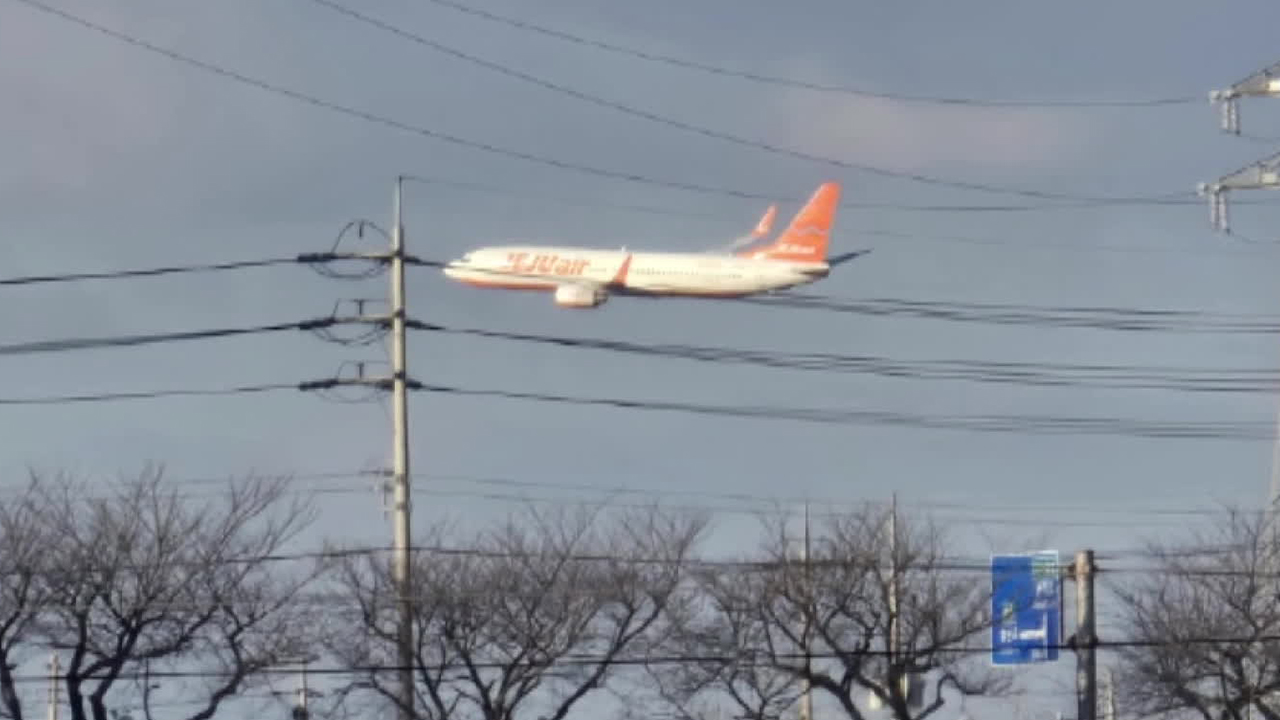Desperate holding fix entry fails due to sudden altitude change
입력 2024.12.31 (00:04)
읽어주기 기능은 크롬기반의
브라우저에서만 사용하실 수 있습니다.
At the time when sparks were flying from both engines.
The flight altitude dropped to 450 feet and then rapidly ascended to 625 feet.
It was raised by 175 feet, about 50 meters.
It seems that the altitude was increased for a go-around.
[Yoo Kyung-soo/Director of Aviation Safety Policy, Ministry of Land, Infrastructure and Transport: "As it was climbing, there was probably some kind of aircraft malfunction, so it should have completely returned in consultation with the control tower and turned back in the opposite direction, but instead, it made an emergency landing on the shorter runway."]
What was the plan afterward?
This is the approach manual for Muan Airport obtained by KBS.
It is a type of navigation that details the airport approach angle and altitude, as well as the re-approach route, set by the aviation authorities.
The landing path to the runway is pre-set, and if a landing fails, like in the case of this Jeju aircraft, a temporary holding fix is also designated to regain control.
The holding fix name for Muan Airport is 'Gufla'.
It is specified to climb to an altitude of 5,000 feet and move 8.3 miles in the 310-degree direction.
The accident aircraft attempted to enter the holding fix according to this manual, but it seems the engines were unresponsive.
[Current Pilot/Voice Altered: "It means to hold at 5,000 feet in the area called Gufla. After going around and trying to gain altitude, I think that for some reason, altitude was not being secured...."]
Unable to gain altitude, the entry into the holding fix was thwarted, and ultimately, it seems they were forced into a belly landing.
[Current Pilot/Voice Altered: "No matter how trained and skilled you are, in such a situation, there is nothing you can do."]
Bird strike, engine malfunction, and failure to enter the holding fix.
The urgent moments are recorded in an abnormal flight path.
This is Lee Do-yoon from KBS News.
The flight altitude dropped to 450 feet and then rapidly ascended to 625 feet.
It was raised by 175 feet, about 50 meters.
It seems that the altitude was increased for a go-around.
[Yoo Kyung-soo/Director of Aviation Safety Policy, Ministry of Land, Infrastructure and Transport: "As it was climbing, there was probably some kind of aircraft malfunction, so it should have completely returned in consultation with the control tower and turned back in the opposite direction, but instead, it made an emergency landing on the shorter runway."]
What was the plan afterward?
This is the approach manual for Muan Airport obtained by KBS.
It is a type of navigation that details the airport approach angle and altitude, as well as the re-approach route, set by the aviation authorities.
The landing path to the runway is pre-set, and if a landing fails, like in the case of this Jeju aircraft, a temporary holding fix is also designated to regain control.
The holding fix name for Muan Airport is 'Gufla'.
It is specified to climb to an altitude of 5,000 feet and move 8.3 miles in the 310-degree direction.
The accident aircraft attempted to enter the holding fix according to this manual, but it seems the engines were unresponsive.
[Current Pilot/Voice Altered: "It means to hold at 5,000 feet in the area called Gufla. After going around and trying to gain altitude, I think that for some reason, altitude was not being secured...."]
Unable to gain altitude, the entry into the holding fix was thwarted, and ultimately, it seems they were forced into a belly landing.
[Current Pilot/Voice Altered: "No matter how trained and skilled you are, in such a situation, there is nothing you can do."]
Bird strike, engine malfunction, and failure to enter the holding fix.
The urgent moments are recorded in an abnormal flight path.
This is Lee Do-yoon from KBS News.
■ 제보하기
▷ 카카오톡 : 'KBS제보' 검색, 채널 추가
▷ 전화 : 02-781-1234, 4444
▷ 이메일 : kbs1234@kbs.co.kr
▷ 유튜브, 네이버, 카카오에서도 KBS뉴스를 구독해주세요!
- Desperate holding fix entry fails due to sudden altitude change
-
- 입력 2024-12-31 00:04:26

At the time when sparks were flying from both engines.
The flight altitude dropped to 450 feet and then rapidly ascended to 625 feet.
It was raised by 175 feet, about 50 meters.
It seems that the altitude was increased for a go-around.
[Yoo Kyung-soo/Director of Aviation Safety Policy, Ministry of Land, Infrastructure and Transport: "As it was climbing, there was probably some kind of aircraft malfunction, so it should have completely returned in consultation with the control tower and turned back in the opposite direction, but instead, it made an emergency landing on the shorter runway."]
What was the plan afterward?
This is the approach manual for Muan Airport obtained by KBS.
It is a type of navigation that details the airport approach angle and altitude, as well as the re-approach route, set by the aviation authorities.
The landing path to the runway is pre-set, and if a landing fails, like in the case of this Jeju aircraft, a temporary holding fix is also designated to regain control.
The holding fix name for Muan Airport is 'Gufla'.
It is specified to climb to an altitude of 5,000 feet and move 8.3 miles in the 310-degree direction.
The accident aircraft attempted to enter the holding fix according to this manual, but it seems the engines were unresponsive.
[Current Pilot/Voice Altered: "It means to hold at 5,000 feet in the area called Gufla. After going around and trying to gain altitude, I think that for some reason, altitude was not being secured...."]
Unable to gain altitude, the entry into the holding fix was thwarted, and ultimately, it seems they were forced into a belly landing.
[Current Pilot/Voice Altered: "No matter how trained and skilled you are, in such a situation, there is nothing you can do."]
Bird strike, engine malfunction, and failure to enter the holding fix.
The urgent moments are recorded in an abnormal flight path.
This is Lee Do-yoon from KBS News.
The flight altitude dropped to 450 feet and then rapidly ascended to 625 feet.
It was raised by 175 feet, about 50 meters.
It seems that the altitude was increased for a go-around.
[Yoo Kyung-soo/Director of Aviation Safety Policy, Ministry of Land, Infrastructure and Transport: "As it was climbing, there was probably some kind of aircraft malfunction, so it should have completely returned in consultation with the control tower and turned back in the opposite direction, but instead, it made an emergency landing on the shorter runway."]
What was the plan afterward?
This is the approach manual for Muan Airport obtained by KBS.
It is a type of navigation that details the airport approach angle and altitude, as well as the re-approach route, set by the aviation authorities.
The landing path to the runway is pre-set, and if a landing fails, like in the case of this Jeju aircraft, a temporary holding fix is also designated to regain control.
The holding fix name for Muan Airport is 'Gufla'.
It is specified to climb to an altitude of 5,000 feet and move 8.3 miles in the 310-degree direction.
The accident aircraft attempted to enter the holding fix according to this manual, but it seems the engines were unresponsive.
[Current Pilot/Voice Altered: "It means to hold at 5,000 feet in the area called Gufla. After going around and trying to gain altitude, I think that for some reason, altitude was not being secured...."]
Unable to gain altitude, the entry into the holding fix was thwarted, and ultimately, it seems they were forced into a belly landing.
[Current Pilot/Voice Altered: "No matter how trained and skilled you are, in such a situation, there is nothing you can do."]
Bird strike, engine malfunction, and failure to enter the holding fix.
The urgent moments are recorded in an abnormal flight path.
This is Lee Do-yoon from KBS News.
-
-

이도윤 기자 dobby@kbs.co.kr
이도윤 기자의 기사 모음
-
이 기사가 좋으셨다면
-
좋아요
0
-
응원해요
0
-
후속 원해요
0












![[단독] 위성락 실장 “전작권 협상 카드 아냐…카드로 써서도 안 돼”](/data/layer/904/2025/07/20250713_uwNBPL.jpg)


이 기사에 대한 의견을 남겨주세요.